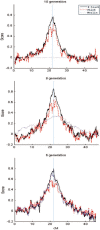Estimating genome-wide IBD sharing from SNP data via an efficient hidden Markov model of LD with application to gene mapping
- PMID: 20529903
- PMCID: PMC2881389
- DOI: 10.1093/bioinformatics/btq204
Estimating genome-wide IBD sharing from SNP data via an efficient hidden Markov model of LD with application to gene mapping
Abstract
Motivation: Association analysis is the method of choice for studying complex multifactorial diseases. The premise of this method is that affected persons contain some common genomic regions with similar SNP alleles and such areas will be found in this analysis. An important disadvantage of GWA studies is that it does not distinguish between genomic areas that are inherited from a common ancestor [identical by descent (IBD)] and areas that are identical merely by state [identical by state (IBS)]. Clearly, areas that can be marked with higher probability as IBD and have the same correlation with the disease status of identical areas that are more probably only IBS, are better candidates to be causative, and yet this distinction is not encoded in standard association analysis.
Results: We develop a factorial hidden Markov model-based algorithm for computing genome-wide IBD sharing. The algorithm accepts as input SNP data of measured individuals and estimates the probability of IBD at each locus for every pair of individuals. For two g-degree relatives, when g > or = 8, the computation yields a precision of IBD tagging of over 50% higher than previous methods for 95% recall. Our algorithm uses a first-order Markovian model for the linkage disequilibrium process and employs a reduction of the state space of the inheritance vector from being exponential in g to quadratic. The higher accuracy along with the reduced time complexity marks our method as a feasible means for IBD mapping in practical scenarios.
Availability: A software implementation, called IBDMAP, is freely available at http://bioinfo.cs.technion.ac.il/IBDmap.
Figures



Similar articles
-
Relatedness mapping and tracts of relatedness for genome-wide data in the presence of linkage disequilibrium.Genet Epidemiol. 2009 Apr;33(3):266-74. doi: 10.1002/gepi.20378. Genet Epidemiol. 2009. PMID: 19025785
-
Efficient identification of identical-by-descent status in pedigrees with many untyped individuals.Bioinformatics. 2010 Jun 15;26(12):i191-8. doi: 10.1093/bioinformatics/btq222. Bioinformatics. 2010. PMID: 20529905 Free PMC article.
-
FastTagger: an efficient algorithm for genome-wide tag SNP selection using multi-marker linkage disequilibrium.BMC Bioinformatics. 2010 Jan 29;11:66. doi: 10.1186/1471-2105-11-66. BMC Bioinformatics. 2010. PMID: 20113476 Free PMC article.
-
Inference of relationships in population data using identity-by-descent and identity-by-state.PLoS Genet. 2011 Sep;7(9):e1002287. doi: 10.1371/journal.pgen.1002287. Epub 2011 Sep 22. PLoS Genet. 2011. PMID: 21966277 Free PMC article.
-
Identity by descent between distant relatives: detection and applications.Annu Rev Genet. 2012;46:617-33. doi: 10.1146/annurev-genet-110711-155534. Epub 2012 Sep 17. Annu Rev Genet. 2012. PMID: 22994355 Review.
Cited by
-
RaPID: ultra-fast, powerful, and accurate detection of segments identical by descent (IBD) in biobank-scale cohorts.Genome Biol. 2019 Jul 25;20(1):143. doi: 10.1186/s13059-019-1754-8. Genome Biol. 2019. PMID: 31345249 Free PMC article.
-
Quantification of transplant-derived circulating cell-free DNA in absence of a donor genotype.PLoS Comput Biol. 2017 Aug 3;13(8):e1005629. doi: 10.1371/journal.pcbi.1005629. eCollection 2017 Aug. PLoS Comput Biol. 2017. PMID: 28771616 Free PMC article.
-
An effective filter for IBD detection in large data sets.PLoS One. 2014 Mar 25;9(3):e92713. doi: 10.1371/journal.pone.0092713. eCollection 2014. PLoS One. 2014. PMID: 24667521 Free PMC article.
-
Accurate detection of identity-by-descent segments in human ancient DNA.Nat Genet. 2024 Jan;56(1):143-151. doi: 10.1038/s41588-023-01582-w. Epub 2023 Dec 20. Nat Genet. 2024. PMID: 38123640 Free PMC article.
-
Integration of SNP genotyping confidence scores in IBD inference.Bioinformatics. 2011 Oct 15;27(20):2880-7. doi: 10.1093/bioinformatics/btr486. Epub 2011 Aug 23. Bioinformatics. 2011. PMID: 21862568 Free PMC article.
References
-
- Abecasis GR, et al. Merlin-rapid analysis of dense genetic maps using sparse gene flow trees. Nat. Genet. 2002;30:97–101. - PubMed
-
- Bercovici S, Geiger D. Inferring ancestries efficiently in admixed populations with linkage disequilibrium. J. Comput. Biol. 2009;16:1141–1150. - PubMed
-
- Browning S, Browning B. On reducing the statespace of hidden markov models for the identity by descent process. Theor. Popul. Biol. 2002;62:1–8. - PubMed
Publication types
MeSH terms
LinkOut - more resources
Full Text Sources
Research Materials

